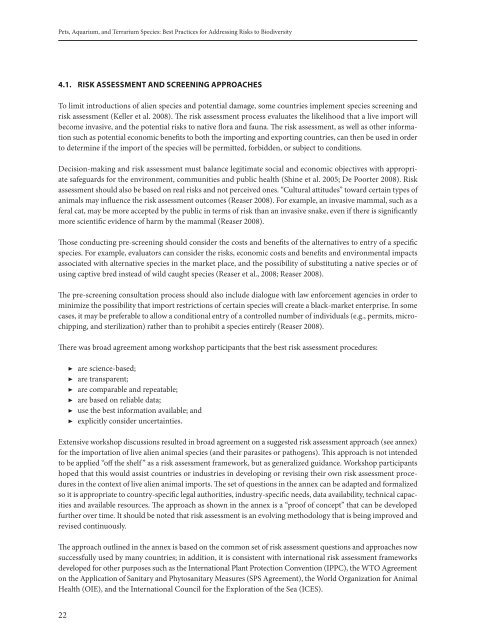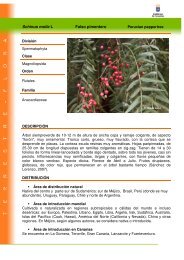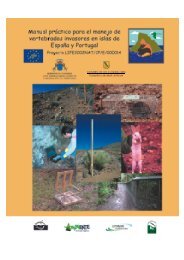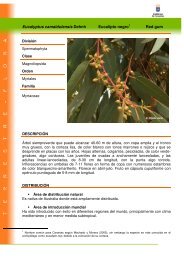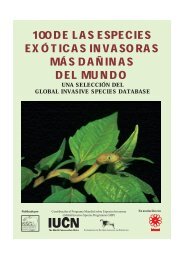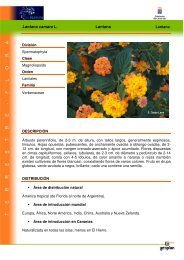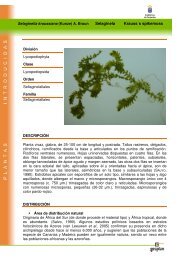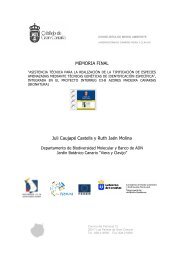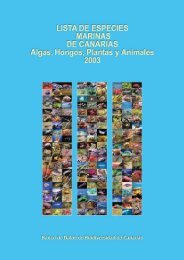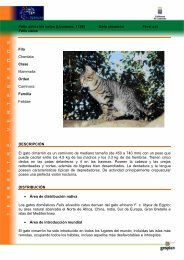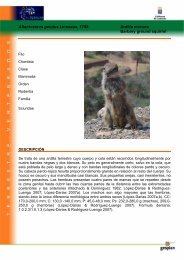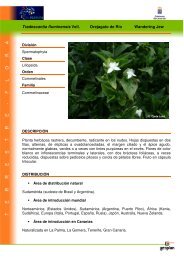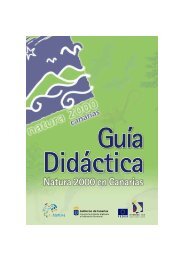Pets, Aquarium, and Terrarium Species - Convention on Biological ...
Pets, Aquarium, and Terrarium Species - Convention on Biological ...
Pets, Aquarium, and Terrarium Species - Convention on Biological ...
You also want an ePaper? Increase the reach of your titles
YUMPU automatically turns print PDFs into web optimized ePapers that Google loves.
<str<strong>on</strong>g>Pets</str<strong>on</strong>g>, <str<strong>on</strong>g>Aquarium</str<strong>on</strong>g>, <str<strong>on</strong>g>and</str<strong>on</strong>g> <str<strong>on</strong>g>Terrarium</str<strong>on</strong>g> <str<strong>on</strong>g>Species</str<strong>on</strong>g>: Best Practices for Addressing Risks to Biodiversity<br />
4.1. Risk Assessment <str<strong>on</strong>g>and</str<strong>on</strong>g> Screening Approaches<br />
To limit introducti<strong>on</strong>s of alien species <str<strong>on</strong>g>and</str<strong>on</strong>g> potential damage, some countries implement species screening <str<strong>on</strong>g>and</str<strong>on</strong>g><br />
risk assessment (Keller et al. 2008). The risk assessment process evaluates the likelihood that a live import will<br />
become invasive, <str<strong>on</strong>g>and</str<strong>on</strong>g> the potential risks to native flora <str<strong>on</strong>g>and</str<strong>on</strong>g> fauna. The risk assessment, as well as other informati<strong>on</strong><br />
such as potential ec<strong>on</strong>omic benefits to both the importing <str<strong>on</strong>g>and</str<strong>on</strong>g> exporting countries, can then be used in order<br />
to determine if the import of the species will be permitted, forbidden, or subject to c<strong>on</strong>diti<strong>on</strong>s.<br />
Decisi<strong>on</strong>-making <str<strong>on</strong>g>and</str<strong>on</strong>g> risk assessment must balance legitimate social <str<strong>on</strong>g>and</str<strong>on</strong>g> ec<strong>on</strong>omic objectives with appropriate<br />
safeguards for the envir<strong>on</strong>ment, communities <str<strong>on</strong>g>and</str<strong>on</strong>g> public health (Shine et al. 2005; De Poorter 2008). Risk<br />
assessment should also be based <strong>on</strong> real risks <str<strong>on</strong>g>and</str<strong>on</strong>g> not perceived <strong>on</strong>es. “Cultural attitudes” toward certain types of<br />
animals may influence the risk assessment outcomes (Reaser 2008). For example, an invasive mammal, such as a<br />
feral cat, may be more accepted by the public in terms of risk than an invasive snake, even if there is significantly<br />
more scientific evidence of harm by the mammal (Reaser 2008).<br />
Those c<strong>on</strong>ducting pre-screening should c<strong>on</strong>sider the costs <str<strong>on</strong>g>and</str<strong>on</strong>g> benefits of the alternatives to entry of a specific<br />
species. For example, evaluators can c<strong>on</strong>sider the risks, ec<strong>on</strong>omic costs <str<strong>on</strong>g>and</str<strong>on</strong>g> benefits <str<strong>on</strong>g>and</str<strong>on</strong>g> envir<strong>on</strong>mental impacts<br />
associated with alternative species in the market place, <str<strong>on</strong>g>and</str<strong>on</strong>g> the possibility of substituting a native species or of<br />
using captive bred instead of wild caught species (Reaser et al., 2008; Reaser 2008).<br />
The pre-screening c<strong>on</strong>sultati<strong>on</strong> process should also include dialogue with law enforcement agencies in order to<br />
minimize the possibility that import restricti<strong>on</strong>s of certain species will create a black-market enterprise. In some<br />
cases, it may be preferable to allow a c<strong>on</strong>diti<strong>on</strong>al entry of a c<strong>on</strong>trolled number of individuals (e.g., permits, microchipping,<br />
<str<strong>on</strong>g>and</str<strong>on</strong>g> sterilizati<strong>on</strong>) rather than to prohibit a species entirely (Reaser 2008).<br />
There was broad agreement am<strong>on</strong>g workshop participants that the best risk assessment procedures:<br />
▶▶<br />
are science-based;<br />
▶▶<br />
are transparent;<br />
▶▶<br />
are comparable <str<strong>on</strong>g>and</str<strong>on</strong>g> repeatable;<br />
▶▶<br />
are based <strong>on</strong> reliable data;<br />
▶▶<br />
use the best informati<strong>on</strong> available; <str<strong>on</strong>g>and</str<strong>on</strong>g><br />
▶▶<br />
explicitly c<strong>on</strong>sider uncertainties.<br />
Extensive workshop discussi<strong>on</strong>s resulted in broad agreement <strong>on</strong> a suggested risk assessment approach (see annex)<br />
for the importati<strong>on</strong> of live alien animal species (<str<strong>on</strong>g>and</str<strong>on</strong>g> their parasites or pathogens). This approach is not intended<br />
to be applied “off the shelf ” as a risk assessment framework, but as generalized guidance. Workshop participants<br />
hoped that this would assist countries or industries in developing or revising their own risk assessment procedures<br />
in the c<strong>on</strong>text of live alien animal imports. The set of questi<strong>on</strong>s in the annex can be adapted <str<strong>on</strong>g>and</str<strong>on</strong>g> formalized<br />
so it is appropriate to country-specific legal authorities, industry-specific needs, data availability, technical capacities<br />
<str<strong>on</strong>g>and</str<strong>on</strong>g> available resources. The approach as shown in the annex is a “proof of c<strong>on</strong>cept” that can be developed<br />
further over time. It should be noted that risk assessment is an evolving methodology that is being improved <str<strong>on</strong>g>and</str<strong>on</strong>g><br />
revised c<strong>on</strong>tinuously.<br />
The approach outlined in the annex is based <strong>on</strong> the comm<strong>on</strong> set of risk assessment questi<strong>on</strong>s <str<strong>on</strong>g>and</str<strong>on</strong>g> approaches now<br />
successfully used by many countries; in additi<strong>on</strong>, it is c<strong>on</strong>sistent with internati<strong>on</strong>al risk assessment frameworks<br />
developed for other purposes such as the Internati<strong>on</strong>al Plant Protecti<strong>on</strong> <str<strong>on</strong>g>C<strong>on</strong>venti<strong>on</strong></str<strong>on</strong>g> (IPPC), the WTO Agreement<br />
<strong>on</strong> the Applicati<strong>on</strong> of Sanitary <str<strong>on</strong>g>and</str<strong>on</strong>g> Phytosanitary Measures (SPS Agreement), the World Organizati<strong>on</strong> for Animal<br />
Health (OIE), <str<strong>on</strong>g>and</str<strong>on</strong>g> the Internati<strong>on</strong>al Council for the Explorati<strong>on</strong> of the Sea (ICES).<br />
22


